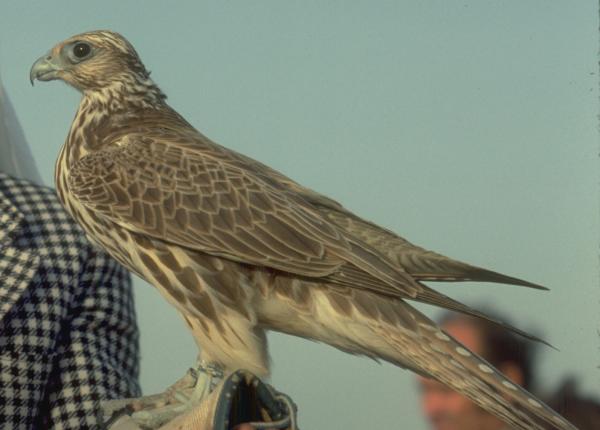Did You Know?
- The Saker Falcon is also known as the Altai Falcon
- There are four recognized sub-species of the Saker Falcon
How The Peregrine Fund is Helping
Though The Peregrine Fund does not work directly with Saker Falcons, our efforts in scientific research, habitat conservation, education, and community development help conserve birds of prey around the world. We also supply literature to researchers from our avian research library, which helps scientists around the world gather and share important information on raptor conservation. Additionally, our support of the Global Raptor Information Network gives raptor researchers tools to more efficiently conduct their own studies while contributing to a global program. It also provides citizen scientists a way to participate in raptor science and conservation.
Where it Lives
The Saker Falcon has a wide range across parts of Europe, Asia, and northern Africa. It can be found in a variety of habitats including forested steppe, steppe, semi-deserts, open grasslands, and other dry country habitat with scattered trees, cliffs, or electricity pylons, particularly near water.
Why it Needs our Help
The Saker Falcon is categorized as an Endangered Species. Habitat loss, indirect poisoning, and trapping are all threats to this beautiful bird. Though in some areas this falcon's populations are stable or increasing, overall, this species' numbers are in decline. In some countries, such as Hungary and Slovakia, these falcons rely heavily on artificial nesting platforms and boxes installed on high voltage power poles by conservation groups.
What it Eats
A powerful falcon, this species preys on a number of different animals including small mammals (susliks, hamsters, voles) and medium-sized birds (rooks, magpies, rollers, larks). In areas where mammalian prey populations are not as easily found birds become a more important part of the diet. This species is also known to steal prey from other species of birds, including raptors! The Saker Falcon can catch prey in flight, but most of the time it snatches prey from the ground. Scientists have observed that breeding pairs will sometimes hunt together.
Nests, Eggs, and Young
Like most other falcons, the Saker Falcon doesn't build its own nest. Instead, it may choose to nest in the old nests of other raptors and ravens in trees, on bare ledges, on top of abandoned buildings, bridges, in potholes of rocky cliffs, on the bare ground, on electricity pylons or power poles. Nest sites are often used over and over through the years. The female will usually lay 3-5 eggs, but clutch size can vary from 2-6 eggs. The eggs are white mixed with a reddish-brown pigment.
The eggs will need to be incubated for around 30 days. The female will take on most of the incubation duties, while the male works hard to find food for himself and the female. When the nestlings hatch they are very small and covered in an off-white down. But they will grow quickly. When they are between 40-45 days old they will be ready to fly from the nest for the first time. Once they are out of the nest, they will remain with their parents for up two months as they learn to become independent.
Saker Falcon and the World Center for Birds of Prey
The World Center for Birds of Prey offers fun ways to learn about birds of prey. From introductory videos, to live raptor presentations with a few "ambassador" falcons on hand, including an Aplomado, Peregrine and Gyrfalcon, a visit to the center has a lot to offer for those interested in learning more about raptors. In addition, interactive activities, tours, interesting videos and a children's room with activities from coloring sheets to quizzes to costumes and a touch table are available for the curious mind. Knowledgeable staff and volunteers are on hand to answer any questions you may have about the Saker Falcon or any other bird of prey.
References:
Global Raptor Information Network. 2022. Species account: Saker Falcon Falco cherrug. Downloaded from http://www.globalraptors.org on 19 Aug. 2022
Orta, J., P. F. D. Boesman, C. J. Sharpe, and J. S. Marks (2020). Saker Falcon (Falco cherrug), version 1.0. In Birds of the World (J. del Hoyo, A. Elliott, J. Sargatal, D. A. Christie, and E. de Juana, Editors). Cornell Lab of Ornithology, Ithaca, NY, USA. https://doi.org/10.2173/bow.sakfal1.01










